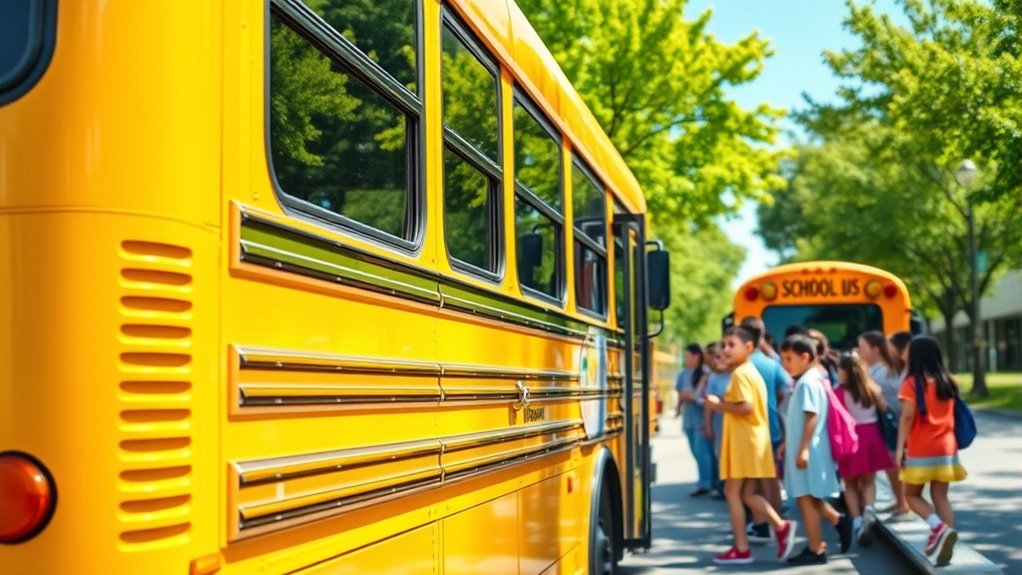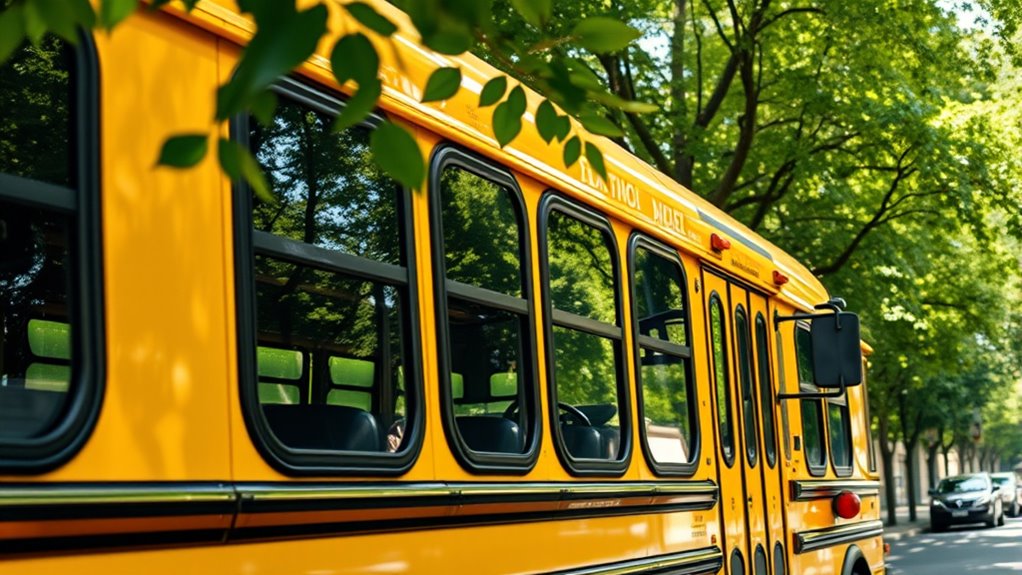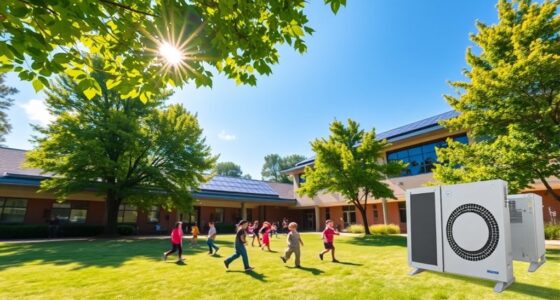Switching from diesel-powered to electric school buses helps protect you and your children from harmful pollution like nitrogen oxides and particulate matter. Electric buses produce no tailpipe emissions, reducing indoor and outdoor air pollution and improving cabin air quality during transit. This benefits everyone’s health, especially children with developing lungs. Plus, electric buses support cleaner communities and a healthier environment. To discover how these changes can impact your school routes, keep exploring the advantages of electric transportation.
Key Takeaways
- Replacing diesel buses with electric models significantly reduces harmful emissions, improving air quality inside and outside the bus.
- Electric buses feature advanced filtration systems that minimize pollutant exposure for passengers, especially children.
- Transitioning to electric buses supports environmental health by decreasing greenhouse gases and outdoor air pollution.
- Upgrading bus ventilation and sealing can reduce the infiltration of diesel fumes into the passenger cabin.
- Continued technological advancements make electric buses more efficient and affordable, enhancing passenger safety and sustainability.

School buses are a vital part of the education system, ensuring students get to and from school safely and reliably. But beyond safety, it’s important to consider how the vehicles impact health, especially when it comes to pollution. Traditional diesel-powered buses emit pollutants that can affect both the environment and passenger air quality. These emissions release nitrogen oxides (NOx), particulate matter (PM), and other harmful substances that contribute to smog and respiratory problems. As a passenger, you might not see or smell these pollutants, but they can still enter the bus cabin through open windows, ventilation systems, or leaks. Over time, exposure to poor air quality can lead to health issues like asthma, allergies, and other respiratory conditions, particularly in children whose lungs are still developing.
Switching to electric buses offers a promising solution. Electric bus emissions are considerably lower or even zero during operation, meaning no tailpipe pollutants are released into the environment. This reduction directly improves passenger air quality, making the ride safer and healthier. When you ride an electric bus, you’re not inhaling diesel fumes or particulate matter, which can linger in the cabin and the surrounding air. Electric buses also tend to have better filtration systems, which further purify the air inside the vehicle, reducing the risk of inhaling airborne toxins. This change not only benefits individual passengers but also contributes to cleaner air in communities, especially near schools and busy bus routes.
Investing in electric buses also aligns with broader efforts to combat climate change. Since these vehicles produce no tailpipe emissions, they help reduce greenhouse gases and air pollutants that contribute to global warming. This shift to cleaner transportation means fewer emissions of pollutants that can settle in the air, leading to improved outdoor air quality around schools and neighborhoods. As a passenger, this means you’re breathing in cleaner air, both inside the vehicle and in the environment you pass through. Additionally, advancements in electric vehicle technology continue to improve the efficiency and affordability of these cleaner transportation options.
Frequently Asked Questions
Are Electric School Buses More Cost-Effective Long-Term?
Yes, electric school buses are more cost-effective long-term. A thorough cost analysis shows lower fuel and maintenance costs compared to traditional diesel buses. You’ll save money on fuel and experience reduced maintenance costs since electric motors have fewer moving parts. Although the initial investment might be higher, the savings over time make electric buses a smart financial choice, especially considering environmental benefits and potential incentives.
How Often Are School Buses Maintained for Emission Standards?
Imagine you’re stepping into a time machine—school buses are maintained regularly, typically every 3,000 to 5,000 miles or at least once a year, whichever comes first. You should guarantee that maintenance schedules include routine emission testing to meet air quality standards. Regular inspections help identify and fix issues that could cause excess pollution, ensuring your bus runs smoothly and emissions stay within legal limits, protecting both passengers and the environment.
Do Newer School Buses Produce Fewer Pollutants?
Yes, newer school buses produce fewer pollutants because they benefit from advanced engine upgrades that reduce diesel emissions. These upgrades include cleaner fuel systems and exhaust after-treatment technologies, which cut down harmful emissions considerably. By choosing newer buses with these improvements, you help lower diesel emissions and improve air quality around schools, protecting passengers and the environment alike.
Are There Government Grants for Upgrading School Bus Fleets?
Yes, there are government grants available for upgrading your school bus fleet. These funding opportunities aim to support fleet modernization, helping you replace older, more polluting buses with cleaner, more efficient models. By applying for these grants, you can decrease emissions, improve air quality, and guarantee a safer environment for your passengers. Keep an eye on federal, state, and local programs designed to promote cleaner transportation and fleet upgrades.
How Can Parents Advocate for Cleaner Transportation Options?
You can advocate for cleaner transportation options by actively engaging with your community and emphasizing student safety. Attend school board meetings, voice concerns about air quality, and push for policies supporting eco-friendly buses. Mobilize other parents, organize petitions, and collaborate with local organizations. Your involvement can create a ripple effect, urging decision-makers to prioritize cleaner transportation. This proactive approach keeps students safe and fosters a healthier environment for everyone.
Conclusion
As you step onto the school bus, imagine it as a shield guarding young travelers from the invisible storm of pollution outside. By choosing cleaner fuels and better filters, you’re not just transporting kids—you’re safeguarding their future, turning each ride into a gust of fresh air. Together, you can paint a brighter, healthier horizon, where every journey is a gentle breeze, and the road ahead is clear and safe for every passenger onboard.









